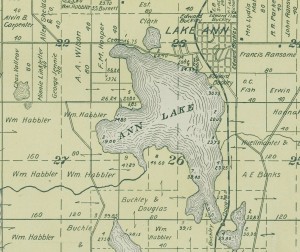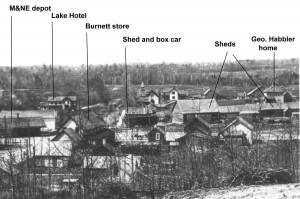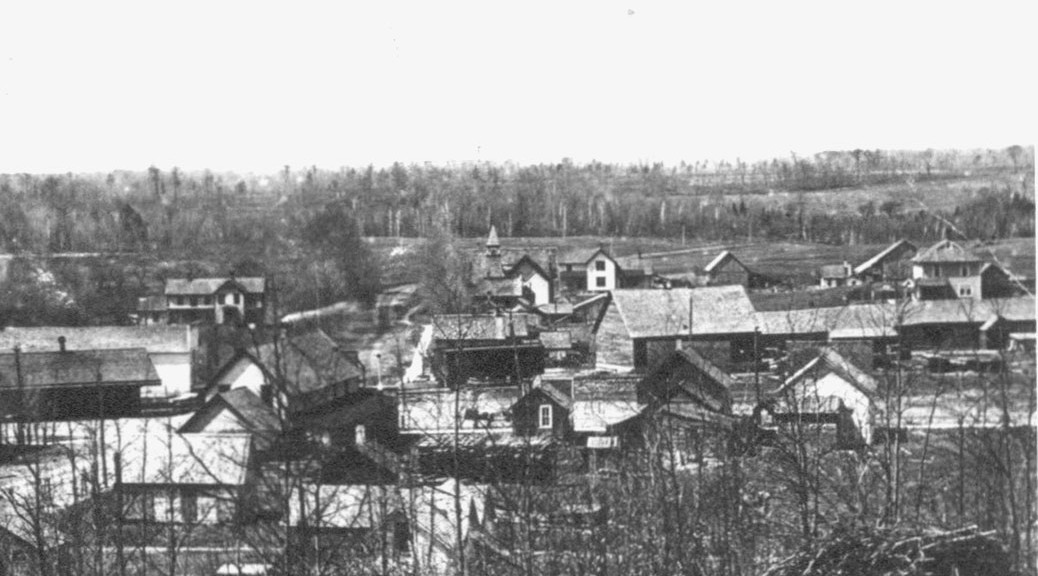by Richard Leary, Lake Ann historian
Three times the village of Lake Ann was nearly destroyed by fire. Twice, the business district was virtually wiped out. Each time the people rebuilt their homes, businesses and lives.
In addition to the three major fires, fire destroyed two prominent business structures: the Douglas Hotel and Bert Smith’s residence, black smith shop and hardware store.
The first and third of the major fires are well-known and were dramatically described in Traverse City newspapers of the day. The second major fire is far less known and the date of the fire wrongly remembered and wrongly published. The dates of the Douglas Hotel and Bert Smith’s store fires were also lost to history.
The following is an accurate account of these five fires complete with citations from newspaper stories of the period. This fascinating, if unfortunate and sad, part of Lake Ann’s history deserves to be remembered correctly.
Lake Ann’s first huge fire
The first and most devastating fire occurred in July 1897. At that time the village was large and prosperous. Its population was about 1,000, making it one of the larger towns in northwestern Michigan. Logging was a major employer and supported several saw mills. The William Habbler Jr mill on the north shore of Ann Lake was the biggest.
The mills brought in many other businesses, from boarding houses to bakeries, grocery stores, barbers and doctors. As in any town employing so many men, saloons, pool parlors and poker games could be found as well.
Some of the buildings and homes were well built and up-to-date architecturally. Businesses were adjacent to one another in the business district. Homes and business buildings were made of wood. Lots were small – often 100 feet deep and 40 feet wide – so homes were close together as well. Other buildings, such as barns, sheds and other out buildings were more rustic and even more flammable.
Once the fire began, apparently from a spark at the Habbler saw mill, a breeze north from the lake spread the fire rapidly through the town. Within minutes it was out of control. Because nearly all the town was north of Ann Lake, just about everything was within the fire’s path.
Because it was Saturday of the Fourth of July weekend, many of the town’s residents had rowed across Ann Lake to a favorite picnic spot on Piney Point. When they saw the smoke and fire in the village, there was little they could do to return home in time to save their belongings.
According to the newspaper accounts of the fire, 50 businesses were lost and 75 homes burned. Most people lost everything they owned.
The Traverse City newspapers gave readers dramatic and complete coverage:
GRAND TRAVERSE HERALD, JULY 8, 1897
Holocaust at Lake Ann
Lake Ann is a mass of smoldering ruins, and there are scarcely thirty buildings left standing. The fire broke out in Habbler’s mill at 1:30 p.m. Saturday and spread through the town with lightening rapidity.
The entire business portion of the village has been swept clean by the most disastrous conflagration that has ever visited this locality.
Not less than 75 families are homeless and nearly all of them have lost all their possessions. Many were fortunate in saving their lives.
The prompt response from Traverse City brought the steam fire engine and twenty members of the department from that city. When the much needed aid arrived, the men who had been fighting fire with all their strength were nearly worn out but they were relieved by the arrival of fresh and efficient help.
When the special train bearing the engine and firemen from Traverse City entered the pall of smoke, the spirits of the discouraged and unfortunate ones arose and hopes of saving what remained were revived.
It required but a few moments to transfer the engine from the flat car to the shore of the lake, just west of the factory, and but five minutes to start two streams.
A well-organized force manned the hose lines, and soon two heavy streams were pouring into the fierce flames which threatened to consume everything that remained.
After a half-hour’s hard work, the flames at the points mentioned were under control. It was necessary to run one line of hose along the shore among the slabs, timber and miscellaneous lumber stock, but the energetic work of the men was effective and showed good results.
The Herald continued with an enthusiastic account of the Traverse City fire department’s efforts:
Traverse City to the Rescue
Fifty-four minutes.
That was the time which elapsed after the fire engine left the Cass street engine house before two powerful streams of water were pouring upon the destructive flames which were destroying the greater portion of Lake Ann Saturday afternoon.
When the special arrived at Lake Ann, the people were almost panic stricken and it seemed as though the entire village was to be swept out of existence. The Traverse City firemen with commendable coolness and precision immediately began work in earnest. Only a few moments were required to transfer the engine to the lake shore, just west of the burning mill and cooperage stock. A team was found at once and the engine hauled to the shore and placed upon an improvised dock of slabs. Firefighter Fulgham lost not a moment and effective streams were doing good work in a few moments.
The men worked with an energy characteristic of the Traverse City firemen and Lake Ann’s business men and citizens felt relieved when the excellently organized force went to work. They labored like tigers and their work immediately began to show satisfactory results, while the engine worked like a charm and threw streams which stayed the fast advancing flames.
An almost identical article appeared in the Morning Record, also Sunday, July 4, 1897. It was perhaps more sensationalist with headlines reading:
HOLOCAUST AT LAKE ANN
Thriving Place swept by Terrible Fire Fiend Yesterday
and Nearly Wiped OutTOWN WILL SUFFER AGGREGATE LOSS OF NEARLY $100,000
Aged Mrs. Masters Cremated In attempting to Save
Valuable Personal PropertyEntire Business of Town in Ruins – Fifty Buildings Destroyed
Seventy-five Families Rendered Homeless and Deprived of
Necessities of Life, also Employment – Traverse City
Responded Promptly to an Appeal for Aid
One can imagine seeing this on the cover of a paper beside the check-out in any grocery store today.

Lake Ann’s second major fire
The date of Lake Ann’s second major fire has been incorrectly known for many years. Even the newspaper report of the third fire, in 1918, gave the wrong date, saying it occurred in 1907. More recently the date has been given as 1914. In reality, it happened in 1902.
The second fire also destroyed most of the Lake Ann business district but it was much smaller than that of 1897. It is clear that little of the village had been rebuilt following the devastating fire in 1897.
Again the Traverse City papers gave it prominent coverage.
THE EVENING RECORD, TUESDAY JANUARY 28, 1902
LAKE ANN FIRE SWEPT
—————–
Business Portion of the Town Again Destroyed
—————–
Lake Ann Jan 28 — Again last night the business portion of Lake Ann was laid in ashes, and nothing but cinders remain of four of the principal businesses places of the town. The saloon building and stock of Dan Willard, the store building of A. B. Huellmantel, the livery barn of W. J. Shilliday and the store building occupied by S. S. Burnett, were completely destroyed and the stock of A. B. Huellmantel and S. S. Burnett were greatly damaged.
“The fire started in the saloon of Dan Willard about 9:30 o’clock. The saloon had been closed for the night and Mr. Willard had gone home. The fire had been banked for the night but in some way a blaze started from the place where the stove pipe passed through the second floor.
Once again, the people of Lake Ann rallied and the village survived and rebuilt.
Douglas Hotel fire
Soon after the fire, a large, elegant hotel opened in the center of town. The hotel, being across the tracks from the M. & N. E. Railroad depot, perhaps served as a destination for people coming on railroad excursions from Manistee or Traverse City. The hotel was close to the shore of Ann Lake and maintained a number of small boats for guests to use on the lake.
Sadly, in 1910 the Douglas Hotel burned to the ground. Fortunately, no one was injured but it was a great loss to the village. A Traverse City newspaper gave complete coverage:
THE EVENING RECORD
TRAVERSE CITY, MICHIGAN, FRIDAY, MAY 13, 1910HOTEL WAS DESTROYED
———–
LAKE ANN HAD A BAD FIRE THIS MORNING
———–
ALL GUESTS ESCAPED
———–
NORTH WIND SAVED THE REST OF VILLAGE
———–
Origin of the fire is unknown but it started in the roof – Loss on building is $2,500 with insurance of $1,200.
———–
Lake Ann, Mich. May 13. — The Hotel Douglas, the only all-year-round house in Lake Ann, was totally destroyed by fire at 6:00 o’clock this morning. The house was well filled with guests but all escaped, although some lost their personal belongings. The loss on the hotel is $2,500 with $1,200 insurance. The insurance on the contents is $1,200 but as some were saved, L. E. Knoedel, the landlord, is unable to give his loss.
The fire originated in the roof near where the two buildings came together. The alarm was quickly given and a bucket brigade was soon on the scene, the men doing very effective work. Fortunately, the wind was from the north, blowing the fire toward the lake, else it is very likely that the entire business street would have been destroyed. It was only by the great effort that the home of Dr. Shilliday and the house and store of S. S. Burnett were saved from destruction.
The fire spread very quickly and while many of the guests were still asleep when the alarm came, all got out fully dressed, although some left their baggage behind. In 10 minutes, the hotel was a heap of smoking ruins.
B. E. Smith’s residence and store
Another major fire happened in 1911. Although not as devastating as the fires of 1897 and 1902, it was significant and probably spectacular.
The following appeared in the April 14, 1911 Benzie Banner:
B. E. Smith’s residence and store were destroyed by fire Monday noon; it was nearly a total loss as only a small part of the contents were saved. Mr. Smith carried no insurance. The rest of the town was only saved by the heroic efforts of the Lake Ann bucket brigade as there were several buildings which caught fire.
Some recollections mention the explosions that occurred as the building burned. The large two-story building was a combination residence, blacksmith shop, livery and hardware store. As such, it no doubt contained hunting ammunition and black powder used for reloading gun shells and blasting tree stumps out of the ground.
Lake Ann’s Third Major Fire
The village of Lake Ann had not experienced its last major fire. The third fire did not destroy the business district, as had the first two big fires. The final fire to sweep through the town primarily burned homes. Once again we look to the newspapers for a compelling account of the conflagration.
Traverse City Record-Eagle, TRAVERSE CITY, MICHIGAN
Friday April 12, 1918 Price – two centsConflagration Destroys Half of Lake Ann Village
BENZIE COUNTY VILLAGE
SUFFERS THIRD DISAS-
TER IN ITS HISTORY
—-
Ten Dwellings, a Church, Three Barns and a Cooperage Laid Low
—-
Half the village of Lake Ann lies in charred ruins today, the result of a fire yesterday afternoon, that swept its course, leveling ten dwellings, the congregational church, three barns and the old cooperage. Nor did the flames stop their ravaging work until every particle of inflammable material in their path had been consumed.
The fire started in the A. Frazer residence, apparently from a defective chimney. Flames were not discovered until the fire was too well under-way that the roof was ready to fall in. A high northeast wind was howling and sparks and flames from the dwelling were carried to the next, and from that, on westward through the town.
Bucket brigades were formed, and farmers, who drove in from miles around, lent their assistance in battling the fire, but to no avail. The fire did not stop until it had exhausted the material, and the balance of the city was spared only because the wild wind did not change.
In spite of the fires that destroyed the town’s business district, Lake Ann survived. An article in the Traverse City Evening Record in 1907 gave evidence of this perseverance.
Lake Ann, Mich. Jan. 10 —Lake Ann was twice visited by disastrous fires. In fact, both conflagrations nearly destroyed the entire town and each time, before the ashes had cooled off, the business men of Lake Ann were planning for the reconstruction and after two hard struggles a pretty village full of life and spirit remains as a result of their perseverance and pluck.
This was just as true after the third fire in 1918 as it was after the second fire.

The village lives on. Habbler’s store, which survived the last two fires, is now the bustling Lake Ann Grocery. S.S. Burnett’s store, rebuilt after the 1902 fire, is now the B & M Party Store and holds down the center of town. Huellmantel’s shoe store, also rebuilt after the 1902 fire, is now a busy restaurant, the Stone Oven. Two new businesses opened in 2014 (The Red Door and Lakeview Realty and Rental Management) and another is scheduled to open early in 2015.
The village of Lake Ann survived three nearly disastrous fires, outlived logging and the M&NE railroad. It continues, in its own way, as a busy, but laid-back, friendly center of activity for locals and tourists alike.
Richard Leary is an active volunteer at the Almira Historical Museum in Lake Ann. Leary is passionate about exploring and documenting the history of Almira Township, and finds inspiration equally in studying written records and in traversing the fields.

